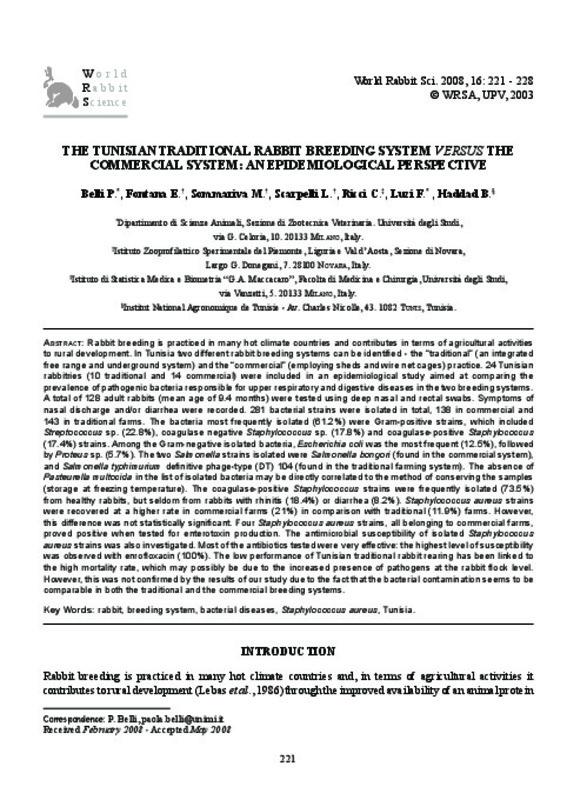JavaScript is disabled for your browser. Some features of this site may not work without it.
Buscar en RiuNet
Listar
Mi cuenta
Estadísticas
Ayuda RiuNet
Admin. UPV
The Tunisian traditional rabbit breeding system versus the commercial system: an epidemiological perspective
Mostrar el registro sencillo del ítem
Ficheros en el ítem
| dc.contributor.author | Belli, P.
|
|
| dc.contributor.author | Fontana, E.
|
|
| dc.contributor.author | Sommariva, M.
|
|
| dc.contributor.author | Scarpelli, L.
|
|
| dc.contributor.author | Ricci, C.
|
|
| dc.contributor.author | Luzi, F.
|
|
| dc.contributor.author | Haddad, B.
|
|
| dc.date.accessioned | 2011-02-08T14:12:26Z | |
| dc.date.available | 2011-02-08T14:12:26Z | |
| dc.date.issued | 2008 | |
| dc.identifier.issn | 1257-5011 | |
| dc.identifier.uri | http://hdl.handle.net/10251/9514 | |
| dc.description.abstract | [EN] Rabbit breeding is practiced in many hot climate countries and contributes in terms of agricultural activities to rural development. In Tunisia two different rabbit breeding systems can be identified - the "traditional" (an integrated free range and underground system) and the "commercial" (employing sheds and wire net cages) practice. 24 Tunisian rabbitries (10 traditional and 14 commercial) were included in an epidemiological study aimed at comparing the prevalence of pathogenic bacteria responsible for upper respiratory and digestive diseases in the two breeding systems. A total of 128 adult rabbits (mean age of 9.4 months) were tested using deep nasal and rectal swabs. Symptoms of nasal discharge and/or diarrhea were recorded. 281 bacterial strains were isolated in total, 138 in commercial and 143 in traditional farms. The bacteria most frequently isolated (61.2%) were Gram-positive strains, which included Streptococcus sp. (22.8%), coagulase negative Staphylococcus sp. (17.8%) and coagulase-positive Staphylococcus (17.4%) strains. Among the Gram-negative isolated bacteria, Escherichia coli was the most frequent (12.5%), followed by Proteus sp. (5.7%). The two Salmonella strains isolated were Salmonella bongori (found in the commercial system), and Salmonella typhimurium definitive phage-type (DT) 104 (found in the traditional farming system). The absence of Pasteurella multocida in the list of isolated bacteria may be directly correlated to the method of conserving the samples (storage at freezing temperature). The coagulase-positive Staphylococcus strains were frequently isolated (73.5%) from healthy rabbits, but seldom from rabbits with rhinitis (18.4%) or diarrhea (8.2%). Staphylococcus aureus strains were recovered at a higher rate in commercial farms (21%) in comparison with traditional (11.9%) farms. However, this difference was not statistically significant. Four Staphylococcus aureus strains, all belonging to commercial farms, proved positive when tested for enterotoxin production. The antimicrobial susceptibility of isolated Staphylococcus aureus strains was also investigated. Most of the antibiotics tested were very effective: the highest level of susceptibility was observed with enrofloxacin (100%). The low performance of Tunisian traditional rabbit rearing has been linked to the high mortality rate, which may possibly be due to the increased presence of pathogens at the rabbit flock level. However, this was not confirmed by the results of our study due to the fact that the bacterial contamination seems to be comparable in both the traditional and the commercial breeding systems. | es_ES |
| dc.language | Inglés | es_ES |
| dc.publisher | World Rabbit Science. ICTA. UPV | es_ES |
| dc.relation.ispartof | World Rabbit Science | |
| dc.rights | Reserva de todos los derechos | es_ES |
| dc.subject | Rabbit | es_ES |
| dc.subject | Breeding system | es_ES |
| dc.subject | Bacterial diseases | es_ES |
| dc.subject | Staphylococcus aureus | es_ES |
| dc.subject | Tunisia | es_ES |
| dc.title | The Tunisian traditional rabbit breeding system versus the commercial system: an epidemiological perspective | es_ES |
| dc.type | Artículo | es_ES |
| dc.date.updated | 2011-02-08T13:10:14Z | |
| dc.identifier.doi | 10.4995/wrs.2008.617 | |
| dc.rights.accessRights | Abierto | es_ES |
| dc.description.bibliographicCitation | Belli, P.; Fontana, E.; Sommariva, M.; Scarpelli, L.; Ricci, C.; Luzi, F.; Haddad, B. (2008). The Tunisian traditional rabbit breeding system versus the commercial system: an epidemiological perspective. World Rabbit Science. 16(4). https://doi.org/10.4995/wrs.2008.617 | es_ES |
| dc.description.accrualMethod | SWORD | es_ES |
| dc.relation.publisherversion | https://doi.org/10.4995/wrs.2008.617 | |
| dc.description.volume | 16 | |
| dc.description.issue | 4 | |
| dc.identifier.eissn | 1989-8886 | es_ES |








